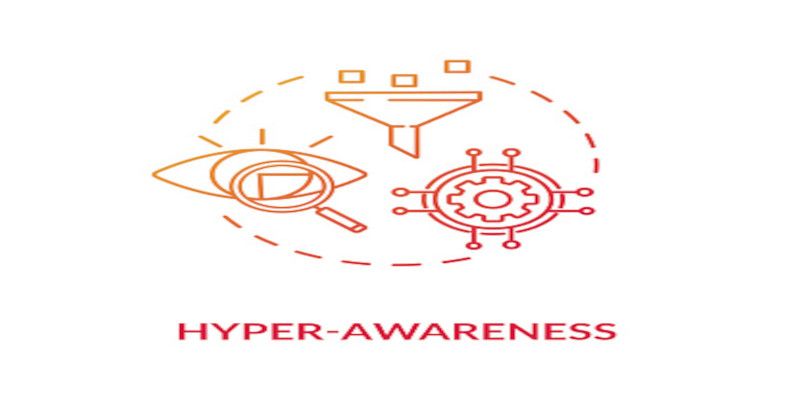Table of Contents
ToggleDo you know that feeling of having to give a presentation at school, or in front of a large crowd, only for you to get nervous and become overly aware of your thoughts, and body? Think of thoughts such as counting how many times you are blinking, or swallowing.
This is what we call hyper-awareness. It can become a chronic issue that can negatively impact many facets of our lives. It can even lead to experiencing depersonalization in some extreme instances.
Fortunately, it is treatable.
There are two types of hyperawareness:
- Behavioral hyperawareness
- Situational hyperawareness
Here’s what they mean, and how they differ.
What is behavioral hyperawareness and situational hyperawareness?

Behavioral hyperawareness
Behavioral hyperawareness stands for being overly aware of your behavior and bodily experiences.
They tend to overanalyze what, and why they’re doing all the things they’re executing, which can negatively impact their mental health.
Situational hyperawareness
Situational hyper-awareness means that one is overly conscious and aware of their surroundings.
This can involve things such as the people around them, how they are perceived by others, the smell of the location, and even visual cues such as being fixated on others and knowing exactly what they’re wearing.
Frequently Asked Questions (FAQ)
What does being hyper-aware mean?
When we are too self-aware is what we call hyperawareness, or hypervigilance.
It refers to an unreasonable, and undesired amount of emotional and psychological energy that goes toward somatic, also called bodily functions. But it’s also possible to be hyperaware of our surroundings.
Examples of these body-focused functions are thoughts, bodily functions, energy levels, and physical sensations.
Possible examples of hypervigilance of our surroundings include knowing how many people are in the room, and how we’re being perceived.
To satisfy these obsessive thoughts, people might resort to things such as regularly checking their phones, counting their breaths, and evening up objects. This can aid them to keep their stress levels in check, at least in the short run.
People in this state are overly aware of themselves, and/or their surroundings. Being hyperaware is not normal, and often a sign of an underlying issue.
It involves being afraid that they’re unable to go back to a state of ‘unawareness’ of their bodily functions and surroundings once they’re hyperaware of their body sensations and/or surroundings.
Hyperawareness and sensorimotor obsessive-compulsive disorder (OCD) are two types of obsessive-compulsive disorders.
What happens when you become too self-aware?

You are at risk for developing chronic hypervigilance when you become too self-aware.
Furthermore, it can also lead to developing chronic stress and anxiety disorders such as evaluation disorders, and social phobias.
Most people suffering from too much self-awareness feel isolated, which can induce loneliness and experiencing chronic stress.
In extreme cases, being overly self-aware can lead to depersonalization. This means feeling like you’re living separated from your own body and thoughts.
What are the 7 forms of OCD?

Obsessive and compulsive disorders (OCD) can be regarded as subtypes of hyperawareness as a consequence of this hypervigilance.
These are the most prevalent types of obsessions:
Somatic hyperawareness/sensorimotor obsessive-compulsive disorder (OCD)
Somatic hyperawareness, also commonly called sensorimotor OCD, means being overly preoccupied and concentrated on our bodily sensations and functions such as swallowing, blinking, and how many times we’re breathing.
The problem is mainly caused due to doubting if this hyperawareness of thoughts and sensations will ever go away. Thus, it means that we see being hypervigilant as an issue.
Emotional contamination OCD
This refers to the fear of being contaminated by someone, somewhere, or something else such as due to bacteria, or in a restroom, for example. What they truly worry about is being put in a dangerous situation by becoming contaminated.
They might also be anxious about the fact that they might become like someone they greatly dislike.
To ‘solve’ the concern, people suffering from this particular OCD go to great lengths to prevent such things from happening. They will not allow themselves to get near, associate, and even live in the same city as that is what gives them OCD.
Of course, this isn’t truly solving the issue. Rather, it’s a way of fleeing from what worries them to reduce the stress that thing causes them. However, to truly solve a problem in life, we need to voluntarily face our fears to become more courageous and less afraid.
Perfectionism OCD

Perfectionism OCD is a tricky one to treat since it is possible to only affect some areas of our lives, while simultaneously not affecting most aspects of our daily lives. This means that some perfectionism can manifest itself as being functional in some cases.
Even so, perfectionism can quickly spiral out of hand and can become a real intrusive issue that greatly impacts our personal lives for the worse.
The main reason why people suffering from it report an issue is because they hold themselves, and frequently others as well, to unattainable high standards. That means that in their eyes, they typically meet ‘total and absolute failure’ because they are unable to reach these ridiculously high standards.
Of course, total failure is quite exaggerated to the people looking at it from the outside, but that doesn’t make this negative feeling any less true to them.
They sense an overwhelming amount of worry and anxiety about making mistakes. As a consequence, they concern themselves with doing things perfectly, since they’re afraid something bad will happen to them if things are not perfect.
Harm OCD

People suffering from self-harm OCD are preoccupied and vexed about invasive thoughts in which they hurt themselves and/or other people. This fear is not exclusive to strangers, but a fear of hurting loved ones can be true as well.
This OCD can lead to a fear of suddenly and uncontrollably hurting other folks or a concern that the person suffering from OCD has hurt someone in the past, and doesn’t remember.
Interestingly enough, people suffering from self-harm OCD are not at an increased risk of harming themselves or others than the folks suffering from another OCD type. They might, however, see these invasive thoughts as an inclination to act out said harmful actions.
Scrupulosity OCD
People enduring this form of OCD report symptoms that involve worries over their own morality. They experience obsessions or compulsions involving religion and/or morals.
They typically feel this intense need to prove to themselves and others that they’re not a bad person, almost like they’re trying to convince themselves. Likewise, they’re willing to go to great lengths to establish and prove it.
The way they accomplish this differs from individual to individual.
Some try to do so through a sense of empathy and compassion, others through promoting equal rights, and others might do it by affiliating themselves with a certain religion that they deem righteous, or by performing acts of self-sacrifice.
Pedophilia OCD
Pedophilia OCD stands for an intense fear that they feel drawn to, and aroused by, children. These harmful or sexual thoughts are unwanted and usually end up in panic, shame, and depression.
Not to mention that it typically also leads to extraordinary fear, not to mention shame since it’s a delicate, and not discussed subject.
In truth, people suffering from this subtype of OCD have no ill will or intention to hurt a child, but they’re tortured by the thoughts of harming them anyway.
Homosexuality OCD
Individuals who suffer from homosexual OCD doubt their own sexual identity. It can lead to a fear of one’s own sexuality because of their thoughts and anxiety about their sexual orientation. It’s also possible to experience mental images of homosexual acts.
They’re afraid of how it might affect their own life, but also that of their loved ones whom they are close to.
It should be noted that people suffering from this type of OCD are not homophobic, nor do they have any unwell feelings toward homosexual folks.
What is the rarest type of OCD?

It’s hard to know exactly what the rarest type of OCD is since we would need to evaluate at least a large sample of people suffering from OCD to get an accurate representative of what the scarcest one is.
Nevertheless, there are some OCD obsessions that we know are less common than others. Think of obsessions such as:
- Somatic (Body-Focused) Obsessions
- Need to Know Obsessions
- Relationship Obsessions
- Existential Obsessions
What is the most severe form of OCD?
Harm OCD can be considered the most severe form of OCD.
It makes people very upset by the savage and hostile thoughts that most people experience at some point in their lives.
However, most people can shrug these thoughts off as nothing more than thinking of their irrational imagination.
But people suffering from harm OCD can’t simply set these thoughts aside. Instead, these thoughts overtake them to the point of modifying their daily lives for the worse.
What is the root cause of OCD?

Experts such as researchers have not been able to figure out exactly what the root cause of OCD is.
The current hypothesis is that genetics, brain abnormalities, and the environment all play a factor in developing obsessive-compulsive disorders.
Interestingly enough, the brain looks perfectly fine and normal in most people suffering from OCD when they get a brain scan. This finding might suggest that brain anomalies might not play such a large factor in developing OCD after all and that the environment might play a crucial factor.
Conclusion
Hyperawareness has multiple advantages, but certainly also disadvantages.
Still, we can all learn to get it under control, and even to get rid of it entirely.
Some of the most effective treatments are psychotherapy and exposure therapy. In rare instances, the obsession and/or compulsion is so severe that medication is also needed as treatment, or because the afflicted person is at risk for self-harm.
Call to action

Firstly, analyze if you have an issue or not. And even more importantly, if it’s negatively impacting certain aspects of your life or not.
If it does negatively affect certain life areas, then you’re most likely suffering from hypervigilance.
Seek professional help, but also support from your loved ones such as family and good friends. It’s a heavy burden, but you shouldn’t have to carry it alone. And the people who care about you will want to help you for sure.




3 thoughts on “What are the types of hyperawareness?”
Comments are closed.